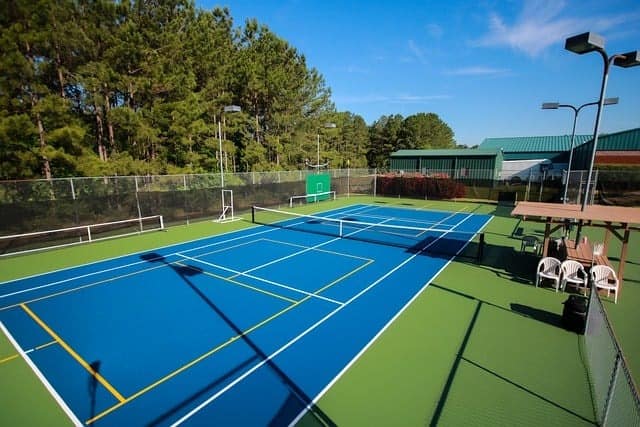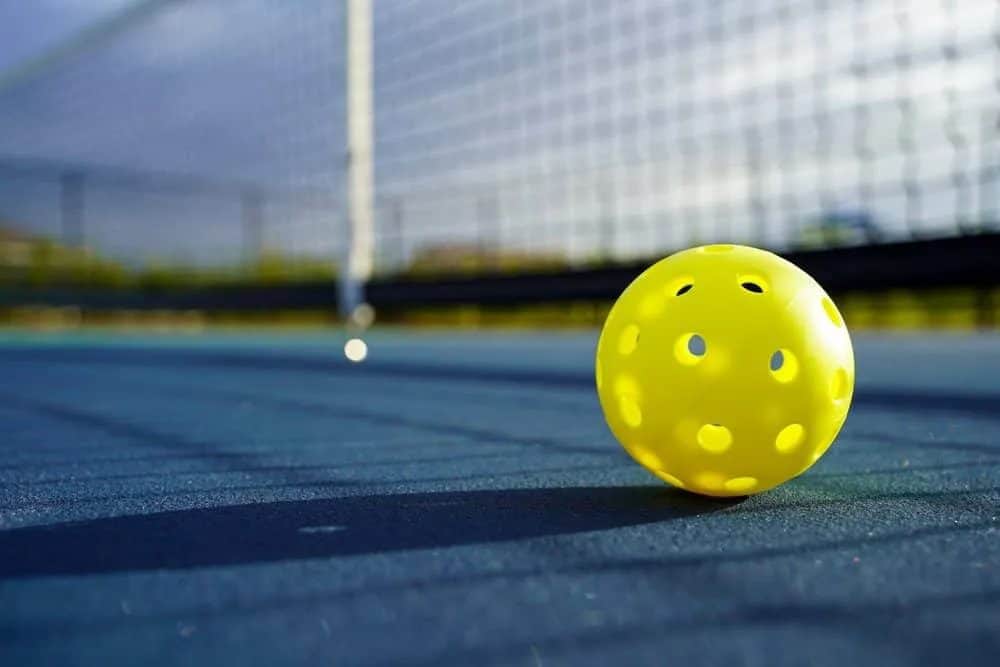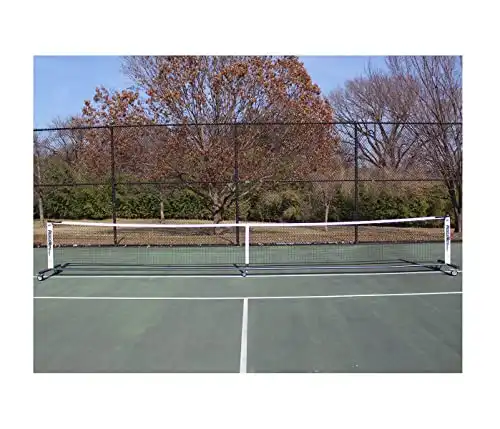Are you ready to step onto the court and unleash your competitive spirit? Whether you’re a pickleball fanatic or a tennis enthusiast, it’s only natural to want to know how a pickleball court differs from a tennis court. When it comes to pickleball courts vs tennis courts, the dimensions of each of these courts can shape your playing experience, and set each sport apart in its own unique way.
Pickleball courts and tennis courts may seem similar at first glance, but trust me, they have less in common than you might think. From court size to specific court lines, there are many differences between a pickleball court and a tennis court.
When it comes to pickleball courts vs tennis courts, the main difference is size. After that, the biggest difference is the one area on a pickleball court called the non-volley zone that only allows volleys after a bounce. Tennis courts simply don’t have an area like this on the court.
When it comes to choosing between pickleball or tennis, the size of the court definitely comes into play. Whether you prefer the finesse of pickleball or the power of tennis, it’s important to understand the differences between these courts and how they contribute to a player’s overall experience.
In this article, I’ll delve into the major and minor differences between pickleball courts and tennis courts!
Why Trust Me?
Before we jump into the topic here, let me take a moment to explain who I am and why you should trust me.
I am a former high school tennis player so I’ve been around the game a long time. In addition to that, I’m an avid pickleball player and play competitively and casually on a weekly basis.
So, both games and more importantly both courts are not new to me. I’ve played both sports and have a really good feeling about how a pickleball court and a tennis court are similar and how they are vastly different.
I am not a brand-new player for each sport. You’re getting someone who knows both games and can speak confidently on the topic. I think that’s important to point out. Ok, with that out of the way, let’s jump into our pickleball courts vs tennis courts comprehensive breakdown.
My Top Pick because its the most durable, reliable, and heavy-duty portable net on wheels made by a brand I trust from personal experience. This is a great pick for those who run YMCA or Community Center leagues.
Comparing Pickleball Courts vs Tennis Courts
Let’s immediately jump in and compare court sizes. Pickleball courts are smaller than tennis courts, measuring 20×44 feet compared to 36×78 feet on a tennis court. The reduced size of pickleball courts allows for a more intimate playing experience, requiring players to cover less ground during the game.
In addition to a bigger court, tennis also has a higher net. A pickleball net is just 36 inches high at the side posts and 34 inches high in the middle, but a tennis net is 42 inches high at the side posts and 36 inches in the middle.
The surface materials used for pickleball and tennis courts may also vary a little. Tennis courts typically have hard surfaces made of asphalt or concrete, providing consistent ball bounce and speed. Outdoor pickleball courts are nearly identical.
On the other hand, indoor pickleball courts are typically made of either specialized plastic or the same material as an indoor gym or basketball court.
The distinct court sizes affect gameplay strategies in both sports. In tennis, the larger court allows for longer rallies and emphasizes powerful shots that cover more distance. In contrast, pickleball’s smaller court size requires players to focus on precision and strategic shot placement rather than relying solely on power.
Pickleball Courts vs Tennis Courts – The Main Difference
When it comes to a pickleball court vs a tennis court, most beginners think the main difference is the court size. And while that is a fundamental difference, there is one area on a pickleball court that cannot be found on a tennis court.
This area is affectionately called “the kitchen” or the non-volley zone. It’s the seven feet of court on either side of the net that enforces the no-volley zone rule. This is the rule in pickleball where if you’re going to step into this area of the court, the ball must be allowed to bounce first.
This a unique rule exclusive to pickleball. You cannot find this area (or this rule for that matter) on a tennis court.
So while the size of the courts is vastly different, it is this small section of a pickleball court that makes it so much different than a tennis court. And it makes pickleball play and feel a lot different too.
For more on net height and how to alter a tennis net to pickleball height regulations, check out my helpful pickleball net height walkthrough.
Key Differences: Pickleball vs Tennis as Sports
Pickleball and tennis are two popular racquet sports that offer unique experiences for players. Let’s explore the key differences between these sports:
- Pickleball combines elements from tennis, badminton, and ping pong to create a distinctive game. It is played on a smaller court compared to tennis, making it more accessible for players of all ages and skill levels.
- In pickleball, the balls used are slower-paced, allowing players more time to react and strategize their moves. On the other hand, tennis involves faster-paced gameplay with larger courts that require greater physical endurance.
- The rules of pickleball differ significantly from those of tennis. For instance, serving techniques vary between the two sports. In pickleball, players must serve underhand diagonally while standing behind the baseline. In contrast, tennis requires an overhead serve with specific guidelines.
- Another notable difference lies in the scoring systems used in each sport. Pickleball follows a scoring system where a point call only be earned by the serving team. Whereas in tennis, a point is earned regardless of who is serving. However, singles pickleball sometimes follows a tennis-inspired “rally scoring” system where a point is earned regardless of serving – but this is uncommon.
- Depending on personal preferences and fitness levels, individuals may gravitate towards one sport over the other. Those seeking a slightly less physically demanding activity might find pickleball more appealing due to its smaller court size and slower ball speed.

Other Key Differences: Pickleball vs Tennis
Pickleball and tennis have many other key differences despite feeling so similar. Here are more fundamental key differences between these two sports:
- Equipment: In pickleball, players use paddles made of composite or wood materials, while tennis players use racquets with strings. The choice of equipment affects the gameplay and the way the ball interacts with the paddle or racquet.
- **Serving Styles:**Pickleball requires an underhand motion, whereas tennis allows for both underhand and overhand serves. This distinction adds variety to each game’s serving strategies.
- Volleying Rules 1a: Both sports involve volleying, which is hitting the ball before it bounces on the ground. However, there are different rules regarding when volleying can be done during gameplay. In pickleball, players must let the ball bounce once on each side before volleying, while in tennis, volleys can be executed at any time.
- Volleying Rules 1b: In addition to the ball needing to bounce twice before volleying can occur, pickleball has a “non-volley zone” area on the court as I mentioned above. This is the one area on a pickleball court that if you step into it, the ball must bounce first. In tennis, you can volley from anywhere on the court.
- Volleying Rules 1b: In addition to the ball needing to bounce twice before volleying can occur, pickleball has a “non-volley zone” area on the court as I mentioned above. This is the one area on a pickleball court that if you step into it, the ball must bounce first. In tennis, you can volley from anywhere on the court.
These distinctions highlight how pickleball and tennis offer unique experiences for players on the court. Whether you prefer the agility required in pickleball or enjoy the strategic elements of tennis, both games provide exciting opportunities for racquet sport enthusiasts.
Playing Pickleball on a Tennis Court: Feasibility and Considerations
Converting a standard-sized tennis court into multiple pickleball courts is possible by adding temporary lines. This allows tennis facilities to accommodate both sports, providing flexibility for players and facilities.
Adjusting the net height may be necessary when playing pickleball on a tennis court to meet regulations. This ensures fair gameplay and maintains the integrity of the sport.
Considering the availability of tennis courts can expand opportunities for playing pickleball. Many communities already have existing tennis courts, which can serve as convenient locations for pickleball enthusiasts.
By utilizing tennis courts for pickleball, players can enjoy various benefits:
- Cost-effective solution: Instead of building new dedicated pickleball courts, using existing tennis facilities saves money.
- Increased accessibility: Utilizing tennis courts means more locations available for pickleball play, making it accessible to a wider range of players.
- Shared resources: Facilities that offer both sports can optimize their space and equipment usage efficiently.
Related: Read my beginner’s guide on how to know if you can play pickleball on a tennis court here.
Setting Up a Pickleball Court on a Tennis Court
Setting up a pickleball court on a tennis court is a convenient and cost-effective way to enjoy the game without the need for additional construction. By applying temporary pickleball lines, you can transform a tennis court into a pickleball court in no time.
Here are some key points to consider when setting up a pickleball court on a tennis court:
- Temporary Lines: To create the boundaries of the pickleball court, you can use tape or chalk to mark the lines on the existing tennis court surface. This allows for easy removal after play.
- Proper Measurements: Ensuring accurate placement of temporary lines is essential for fair gameplay. Measure and mark the dimensions of both singles and doubles courts according to official regulations.
- Net Placement: The net used in pickleball is shorter than that of tennis, so it needs to be adjusted accordingly. Set up the pickleball net at 36 inches height at the center and secure it properly.
- Volley Zone: Just like in regular pickleball courts, marking the non-volley zone (also known as “the kitchen”) near the net is necessary. This area helps maintain fairness by restricting players from volleying within seven feet of the net.
- Scoring System: Pickleball follows its own unique scoring system, which differs from traditional tennis scoring rules. Make sure players are familiar with how points are earned and when serves change sides.
By utilizing an existing tennis court for pickleball, you save time and resources while still enjoying this exciting sport. Whether you’re playing with friends or organizing an event, converting a tennis court into a temporary pickleball oasis provides endless opportunities for fun and competition.
So grab your paddle, gather your friends, and get ready to experience all that this versatile sport has to offer right on your local tennis court!
For a more permanent option, I created a beginner’s guide to painting pickleball lines on a tennis court.

Equipment Comparison: Paddle vs Racquet
Pickleball paddles and tennis racquets are essential equipment in paddle sports. While both serve the purpose of hitting a ball, there are notable differences between them that can affect gameplay. Let’s explore the key factors to consider when choosing between a paddle and a racquet.
- Size and Weight: Pickleball paddles are smaller and lighter compared to tennis racquets. This allows pickleball players to have better maneuverability on the court, enabling quick reactions and precise shots.
- Power and Control: Tennis racquets offer more power due to their larger size and string tension options. The increased surface area of the racquet head allows for greater force behind shots, making it easier to hit powerful serves and groundstrokes. On the other hand, pickleball paddles provide better control over shots due to their smaller size, allowing players to place the ball with accuracy.
- Grip Styles: The grip styles differ between paddle handles and racquet grips, impacting player comfort and control. Pickleball paddles typically have thicker grips that allow for a firm hold during gameplay, reducing hand fatigue. In contrast, tennis racquets offer various grip sizes and shapes that cater to individual preferences.
Ultimately, choosing between a paddle or a racquet depends on personal preference and playing style:
- If you value maneuverability, control, and precision shots, a pickleball paddle may be your preferred choice.
- If power-hitting is your forte and you enjoy longer rallies from the baseline in tennis, then a tennis racquet might suit you better.
Consider experimenting with both options before settling on one. Some players even enjoy participating in both pickleball and tennis by switching between these different equipment choices based on their mood or specific game requirements.
Pickleball Courts vs Tennis Courts – My Final Thoughts
When it comes to pickleball courts vs tennis courts, in some parts of the country pickleball courts are more accessible and offer a more inclusive playing experience. Also, the smaller court size and slower ball speed make it easier for players of all ages and skill levels to participate and enjoy the game.
If you’re considering playing pickleball on a tennis court, it is feasible with some considerations. Adapting the existing tennis court by marking pickleball lines can provide a convenient option for those who don’t have access to dedicated pickleball courts.
To fully enjoy the benefits of playing pickleball, setting up a dedicated court is what I would recommend. Now get out there and go have some fun!
FAQs
Can I play pickleball on a regular tennis court?
Yes! It is possible to play pickleball on a regular tennis court by marking specific lines for the game. However, converting or setting up a dedicated pickleball court provides an optimal experience.
What equipment do I need to play pickleball?
To play pickleball, you will need a paddle (similar to table tennis) and a special perforated ball designed specifically for this sport.
Is there an age limit or skill requirement for playing pickleball?
No! Pickleball welcomes players of all ages and skill levels. It is a sport that can be enjoyed by both beginners and seasoned athletes.
How does pickleball differ from tennis?
Pickleball has a smaller court, slower ball speed, and different rules compared to tennis. It emphasizes shorter rallies and strategic shot placement.
Can I use a tennis racquet to play pickleball?
While it is possible to use a tennis racquet for pickleball, it is recommended to use a paddle designed specifically for this sport. Paddles offer better control and maneuverability.

Welcome to TheVolleyLlama.com. My name is Keith, I’m just a lover of all sports that involve a racquet, net and a ball. I played competitive high school varsity tennis, love racquetball and my whole family plays pickleball regularly. I started this website to help give people like you the basics to learn these wonderful games.


